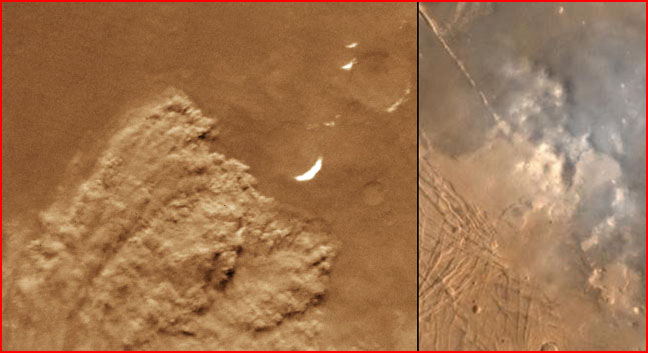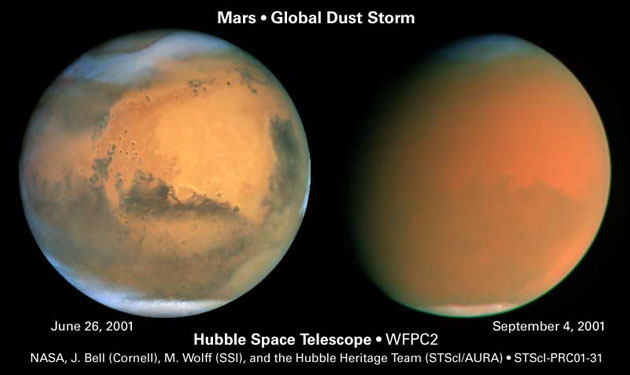
CREDIT: LEFT,Calvin J. Hamilton.
National Optical Astronomy Observatory/Association of Universities for Research in Astronomy/National Science Foundation;
RIGHT, NASA/JPL
Posted on 03/28/2005 10:19:07 PM PST by Swordmaker
Another surprise from space: Massive dust storms on Mars have meteorologists scrambling for explanations. Is it solar heating, or electricity, that powers these storms in the near vacuum of the Martian atmosphere?

CREDIT: LEFT,Calvin J. Hamilton.
National Optical Astronomy Observatory/Association of Universities for Research in Astronomy/National Science Foundation;
RIGHT, NASA/JPL
The spacecraft Mariner 9 was the first probe to orbit the planet Mars. As it arrived at the Red Planet in 1971, NASA scientists were shocked by the view—the most horrific dust storm they had ever seen. The entire planet was engulfed in a deep haze, with only the peak of gigantic Olympus Mons penetrating through the clouds.
For several decades, the energetic dust storms on Mars have posed unanswered questions for meteorologists. How can an atmosphere only one percent as dense as Earth’s remove dust from the soil and accelerate it into massive clouds circling the planet up to 40 miles or more above the surface?
In late June, 2001, the Hubble Telescope revealed the first stirrings of a dust storm in a small region of the Hellas Basin on Mars. For several days the storm alternately grew, then retreated. Then it exploded and quickly boiled out of the Hellas Basin, spreading both north and east. Within a few weeks it had covered the whole planet.

The storm did not begin to subside until October. It was the greatest dust storm ever observed on Mars, and it left meteorologists scratching their heads. How was the dust excavated from the surface? What held the dust aloft? What accelerated the winds and dust across the near vacuum of Mars’ upper atmosphere to speeds greater than 250 miles per hour?
With its Thermal Emission Spectrometer (TES), the orbiting Mars Global Surveyor measured thermal effects associated with the storm. As the storm clouds began to surround Mars, temperatures rose a stunning 40 degrees C—a case of “instantaneous global warming” that continues to haunt meteorologists.
Phil Christensen of Arizona State University, one of the principal investigators of the Martian phenomenon, acknowledges that the specialists do not really know, in “detail,” the causes of the Martian dust storms. Some have theorized that as Martian dust clouds grow thicker, they absorb more warmth from the Sun, raising the temperature of the atmosphere—“a positive feedback loop that can transform tiny dust clouds into globe-swallowing storms”, as one science writer put it. With this reasoning one might wonder why the dust storms ever stop. Indeed, those following this reasoning are not sure why they do stop. ("In fact, we're not certain what makes them stop," states Christensen.)
Most “explanations” of the dust storms begin with radiant energy from the Sun. It is known that the storms are most frequent and severe when Mars is near perihelion (its closest approach to the Sun). So the specialists believe that thermal effects of solar radiation must provide the energy of the storms. But this rationale requires an effect considerably more energetic than the cause. Mars’ orbit has an eccentricity of 0.093. Although greater than the Earth’s orbital eccentricity of 0.017, at Mars’ distance from the Sun the change has little more than a trivial influence on radiant energy input. In fact, if thermal effects are the cause, then seasonal orientation of the planet’s axis should contribute much more to dust storms—with clear hemispheric differentiation. This is not the case, however.
But in the Electric Universe, interplanetary currents focused on the Sun play a vital role in charging up planetary ionospheres—a key to understanding the evolution of weather systems. Electric theorist Wallace Thornhill likens the Earth’s atmosphere to the “self repairing, leaky insulation” between the conductive plates of a global capacitor. The conducting ionosphere forms one plate of the spherical capacitor, while the Earth’s surface is the other. Lightning manifests the “leakiness” of the capacitor, as currents break through the insulating atmosphere to dissipate charge.
The clear-air voltage gradient of Earth at sea level is about 100 volts per meter. In standard meteorology, it is the electric power of thunderstorms that “charge-up the ionosphere”. But the electric theorists see this as an inversion of cause and effect. There would be no thunderstorms in the absence of Earth’s electric field.
Since Mars has no thunderstorms to “charge-up its ionosphere,” it should present a good case study of the Electric Universe. The electrical model predicts that the Martian ionosphere is indeed charged, and it posits no isolated dynamo to “separate charge.” On Mars, electrical effects will reach directly from the ionosphere to the surface without the ameliorating leakage via storm clouds that we see on Earth. Unlike radiant energy from the Sun, electrical energy can accumulate in the “planetary capacitor” for some time, with a potential for planet-altering events when the atmosphere finally “breaks down” and massive discharge activity is initiated.
There is also another aspect to the interplanetary circuitry affecting Mars. The greatest storm on Mars (2001) occurred when the planet was nearing perihelion and was the closest it had been to Earth in about 12 years. At that time it was also being “tickled” by the Earth’s plasma sheath, or magnetosphere, establishing a temporary electrical connection between Earth and Mars for the transfer of charge. It seems that Mars responded with an outburst of atmospheric discharges, these taking the form of monstrous dust devils—or more accurately, electrical tornadoes. See Picture of the Day for March 22, 2005, Dust Devils—or Tornadoes.
At the same time the electric currents flowing in the Martian ionosphere will drive the high-speed winds in the upper atmosphere.
In the two Martian dust storm images above, it appears that the dust is being jetted upwards rather than being blown along the surface. This is explicable in the electric tornado model and explains how dust is raised efficiently many kilometers into the thin air and suspended for a time electrostatically. The role of violent vortices on the leading edge of dust storms is particularly clear in the image we’ve placed here. Closer examination should show that these tornadoes form preferentially on high points and the sharp edges of craters or escarpments.
The twisting columns on the leading edge of the storm suggest vertical movement that is inconceivable in an electrically inert near-vacuum. Perhaps the closest analog to these columns is the network of twisted filaments—electric tornadoes, according to Thornhill—seen most clearly erupting from beneath the Sun’s photosphere on the margins of sunspots.
The Electric Universe identifies the dust storms on Mars as electric discharges etching the surface in the same way that, in industrial applications, electric discharge machining etches metallic surfaces. Though the Martian tornadoes and dust storms lack the power of the electric arcs that carved planetary surfaces in a former epoch, they can certainly leave their signature on the Martian surface today. In space, another good analog would be the newly forming dust jets of comets, when they begin to etch the surface of the nucleus as it enters more deeply into the Sun’s electric field. See Picture of the Day, Dec 29, 2004, Electric Comets and the ‘Domino Effect. See also: Electric Dust Devils.
More Electric Universe PING!
Gee, this story missed the NYTs.
Puh-leeze
this is the james mccanney crap
No, there are other plasma physicists who are looking at this seriously. No Planet X here...
:') Thanks again, a great topic.

Nucleus of Comet Wild 2

Nucleus of Comet Borrelly
Where is the dirty snowball?
Clumps of rock and various ices.
Dirty snowball.
NASA Reports both comets to be dry.
spacewalking ping
Red Planet's Ancient Equator Located
Scientific American (online) | April 20, 2005 | Sarah Graham
Posted on 04/24/2005 8:18:25 PM PDT by SunkenCiv
http://www.freerepublic.com/focus/f-chat/1390424/posts
Since Deep Impact (dry) and Rosetta (wet) had different results, and Deep Impact's look at Tempel 1 differed from what it saw with other comets, it seems we might have different types of comets, as well as heterogeneities within comets. This wouldn't be so odd, considering the variation in other objects (meteorites, planets, etc.)
Disclaimer: Opinions posted on Free Republic are those of the individual posters and do not necessarily represent the opinion of Free Republic or its management. All materials posted herein are protected by copyright law and the exemption for fair use of copyrighted works.